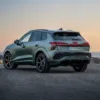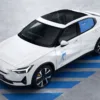While some car brands dabble in hoverboards, a German automaker is venturing into space. In fact, Audi has decided to embark on a lunar mission in collaboration with a team of amateur scientists from Germany and Austria and become the first automobile brand to drive on the surface of the Moon and the first vehicle to be there since Apollo 17. With the Audi Lunar Quattro will participate in the Google Lunar XPRIZE prize competition with a cash fund of 30 million US dollars.
Concept vehicle Audi Lunar Quattro is for the moon. Literally. It is a robotic vehicle for exploring the surface of the Moon, which will be created from under your fingers amateur scientists and other experts under patronage Audi. The German auto giant will contribute solutions related to electronic drive, autonomous driving and materials, but it will not even pass their technical knowledge regarding road grip, where they will be their own quattro four-wheel drive applied for the lunar surface.
READ MORE: New Audi Q7 – Mr. Big
The German-Austrian team of amateur scientists who will be the heart of Audi's Luna mission in the competition Google Lunar XPRIZE, will count 35 engineers, and will also be among them Jack Crenshaw, once employed at NASA. Apart from Audi, the group's patrons are also others high-tech companies, research institutes and the Technical University of Berlin. Responsibility for the appearance of the concept, which will go on the hunt for the rich monetary malha of the competition, which 30 million dollars promises the first team to develop a vehicle that will be able to beat at least on the moon 500-meter distance and send to Earth high definition video, was taken over by Audi's concept design studio. The space vehicle will bring knowledge from both racing and production models, and each wheel should turn for 360 degrees.
On a five-day and 384,400 kilometers long journey to the Moon, where the temperature fluctuates by more than 300 degrees, is supposed to fly in 2017 and landed not far from where it landed in 1972 Apollo 17, which was also NASA's last human mission to the Moon. It will move at speed there 3.6 km/h and document your journey in high resolution in between with a pair of stereoscopic 3D cameras and a camera. The vehicle has already passed the first tests in the Alps of our northern neighbors and in Tenerife, Spain.
More information:
lunar.xprize.org













